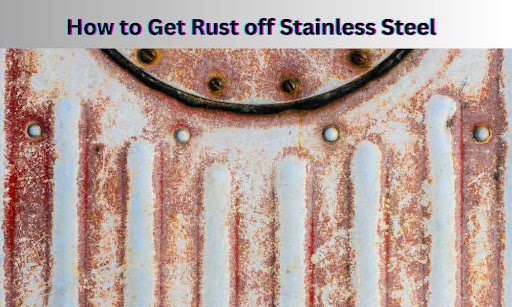How to Get Rust off Stainless Steel

Stainless steel is renowned for its durability, aesthetic appeal, and corrosion resistance. However, it is not completely immune to rust. When rust does appear, it can tarnish the look and reduce the lifespan of your stainless steel welding items. This comprehensive guide will walk you through various methods to effectively remove rust from stainless steel, ensuring your appliances, fixtures, and utensils remain in pristine condition.
Before diving into the removal methods, it’s essential to understand why stainless steel rusts. Stainless steel contains iron, chromium, nickel, and other metals. The chromium in the alloy forms a protective layer of chromium oxide, which prevents rust. However, if this layer is damaged or compromised, rust can form.
Common causes of rust on stainless steel include
Exposure to saltwater or chlorine
Prolonged contact with water
Scratches or damage to the protective layer
Exposure to harsh chemicals
Preparing for Rust Removal
Safety First
When removing rust from stainless steel, ensure you are working in a well-ventilated area. Use protective gloves and eyewear to protect yourself from any chemicals or abrasive materials.
Gather Necessary Materials
Depending on the method you choose, you will need some or all of the following materials:
Baking soda
Vinegar
Lemon juice
Cream of tartar
Commercial rust remover
Non-abrasive scrubbers or sponges
Soft cloths
Aluminum foil
Olive oil or baby oil
Natural Methods to Remove Rust
Baking Soda Paste
Baking soda is a mild abrasive that can effectively remove rust without damaging the stainless steel surface.
Steps:
Mix baking soda with water to form a thick paste.
Apply the paste to the rusted areas using a soft cloth or sponge.
Let it sit for 15-20 minutes.
Gently scrub the area with a non-abrasive scrubber or sponge.
Rinse thoroughly with water and dry with a soft cloth.
Vinegar
Vinegar, particularly white vinegar, is acidic and can dissolve rust effectively.
Steps:
Soak a cloth or paper towel in white vinegar.
Wrap the soaked cloth around the rusted area.
Let it sit for 1-2 hours.
Remove the cloth and scrub the area with a non-abrasive scrubber.
Rinse with water and dry thoroughly.
Lemon Juice and Baking Soda
Lemon juice contains citric acid, which can help dissolve rust.
Steps:
Mix lemon juice with baking soda to form a paste.
Apply the paste to the rusted areas.
Let it sit for 15-30 minutes.
Scrub the area with a non-abrasive scrubber.
Rinse with water and dry with a soft cloth.
Cream of Tartar
Cream of tartar, combined with hydrogen peroxide, can also be effective in removing rust.
Steps:
Mix cream of tartar with a few drops of hydrogen peroxide to form a paste.
Apply the paste to the rusted areas.
Let it sit for 30 minutes.
Scrub the area gently with a non-abrasive scrubber.
Rinse thoroughly and dry with a soft cloth.
Commercial Rust Removers
If natural methods don’t yield the desired results, you can opt for commercial rust removers specifically designed for stainless steel. Follow the manufacturer’s instructions carefully and always test on a small, inconspicuous area first to ensure it doesn’t damage the surface.
Bar Keepers Friend
Bar Keepers Friend is a popular cleaning product known for its rust-removing properties.
Steps:
Sprinkle Bar Keepers Friend powder on a damp sponge or cloth.
Rub the rusted area gently.
Let it sit for a few minutes.
Rinse thoroughly with water and dry with a soft cloth.
WD-40
WD-40 is a versatile product that can help remove rust and protect against further corrosion.
Steps:
Spray WD-40 on the rusted areas.
Let it sit for 10-15 minutes.
Scrub the area with a non-abrasive scrubber.
Wipe off with a clean cloth and rinse with water.
Preventing Rust on Stainless Steel
Preventing rust on stainless steel is as important as removing it. Here are some tips to help keep your stainless steel items rust-free:
Regular Cleaning
Clean your stainless steel items regularly with mild soap and water. Avoid using harsh chemicals or abrasive cleaners that can damage the protective layer.
Dry Thoroughly
Always dry your stainless steel items thoroughly after cleaning to prevent water spots and corrosion. Use a soft cloth to wipe them dry.
Use a Protective Coating
Applying a thin layer of olive oil or baby oil can create a protective barrier on the stainless steel surface. This helps to repel water and reduce the risk of rust formation.
Steps:
Apply a few drops of olive oil or baby oil to a soft cloth.
Rub the cloth over the stainless steel surface in the direction of the grain.
Buff the surface with a clean, dry cloth to remove excess oil.
Avoid Chlorine and Salt
Keep stainless steel items away from chlorine and salt, as these can cause rust. If your stainless steel is exposed to saltwater or chlorine, rinse it thoroughly with fresh water and dry immediately.
Use Stainless Steel Cleaners
Regularly use stainless steel cleaners to maintain the protective layer and keep the surface looking new. These cleaners are formulated to clean without damaging the stainless steel.
Benefits of Professional Rust Removal
Expertise and Experience
Professionals bring expertise and experience to the table, ensuring the rust removal process is thorough and effective. They understand the different types of stainless steel and the best methods to treat each one.
Advanced Techniques and Equipment
Professional welding services companies have access to advanced techniques and specialized equipment, such as
Sandblasting
Uses abrasive materials to remove rust and prepare the surface for refinishing.
Electrolytic Cleaning
An electrochemical process that removes rust without damaging the base material.
Chemical Treatments
Professional-grade chemicals that dissolve rust more effectively than household solutions.
Safety
Handling large-scale rust removal can involve hazardous chemicals and equipment. Professionals are trained to manage these safely, reducing the risk of injury or damage.
Long-Term Solutions
Professionals can provide long-term solutions, including applying industrial-grade protective coatings and conducting regular maintenance to prevent future rust.
Conclusion
Removing rust from stainless steel requires a bit of effort and the right approach, but it is entirely manageable. Whether you choose natural methods like baking soda and vinegar or commercial products like Bar Keepers Friend, the key is to act promptly and carefully to restore the stainless steel’s shine and durability.
FAQs
Can stainless steel rust be removed permanently?
Yes, rust can be removed permanently from stainless steel, but it’s essential to maintain the protective layer to prevent future rust formation. Regular cleaning and preventive measures can help achieve this.
Is it safe to use commercial rust removers on stainless steel?
Yes, it is safe to use commercial rust removers specifically designed for stainless steel. Always follow the manufacturer’s instructions and test on a small area first to ensure compatibility.
What is the best natural rust remover for stainless steel?
Baking soda and vinegar are among the best natural rust removers for stainless steel. They are effective, safe, and readily available.
How often should I clean my stainless steel items to prevent rust?
Regular cleaning, ideally once a week, can help prevent rust formation on stainless steel. Drying the items thoroughly after each use and applying a protective coating can further enhance rust prevention.
Can I use steel wool to remove rust from stainless steel?
No, it is not recommended to use steel wool to remove rust from stainless steel as it can scratch and damage the surface. Use non-abrasive scrubbers or sponges instead.





